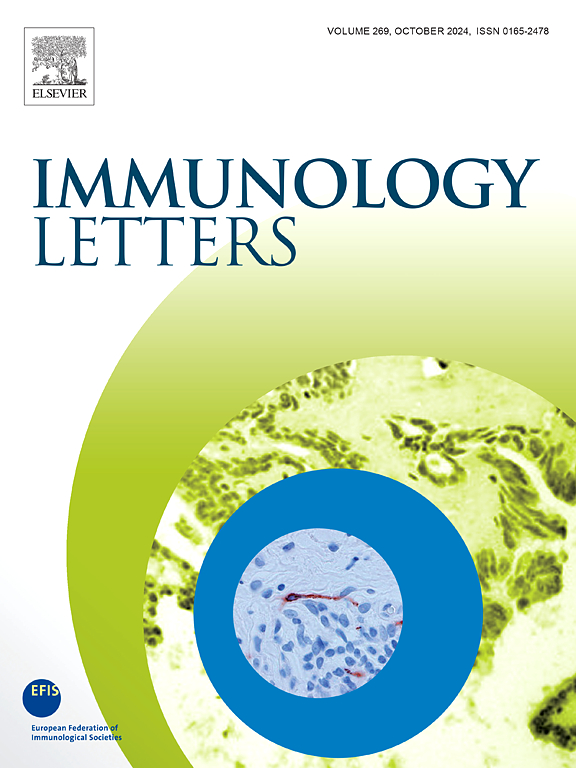DUSP14 attenuates airway inflammation and mucus hypersecretion in allergic asthma by regulating TAK1 activity
IF 2.8
4区 医学
Q3 IMMUNOLOGY
引用次数: 0
Abstract
Allergic asthma is characterized by persistent chronic airway inflammation, leading to mucus hypersecretion and airway hyperresponsiveness. Dual-specificity phosphatase 14 (DUSP14), a member of the DUSP family, is a key regulator in various biological processes. However, the function of DUSP14 in allergic asthma remains to be elucidated. In this study, we aim to explore the function and mechanism of DUSP14 in asthma-related airway inflammation. In an ovalbumin (OVA) asthma mouse model, DUSP14 was found to be significantly diminished. DUSP14 overexpression relieved airway inflammation and attenuated airway mucus production. In vitro, overexpression of DUSP14 attenuated IL-13-induced cellular inflammation and mucus hypersecretion in bronchial epithelial cells (BEAS-2B). Afterwards, we used the co-immunoprecipitation assay to confirm that DUSP14 interacted with TAK1. DUSP14 overexpression restrained the activation of TAK1 and NF-κB signaling pathway in vitro and in vivo. Taken together, our findings clearly showed that DUSP14 could alleviate airway inflammation by inhibiting TAK1 activity and NF-κB signaling pathway, positioning the DUSP14-TAK1-NF-κB regulatory axis as a potential therapeutic target for allergic asthma.
DUSP14通过调节TAK1活性减轻变应性哮喘气道炎症和粘液高分泌。
过敏性哮喘的特点是持续的慢性气道炎症,导致粘液分泌过多和气道高反应性。双特异性磷酸酶14 (dual -specific phosphatase 14, DUSP14)是DUSP家族成员之一,是多种生物过程的关键调控因子。然而,DUSP14在变应性哮喘中的作用仍有待阐明。本研究旨在探讨DUSP14在哮喘相关气道炎症中的作用及机制。在卵清蛋白(OVA)哮喘小鼠模型中,发现DUSP14明显减少。DUSP14过表达可缓解气道炎症,减少气道粘液产生。在体外,DUSP14的过表达减轻了il -13诱导的支气管上皮细胞的细胞炎症和粘液高分泌(BEAS-2B)。随后,我们使用共免疫沉淀法确认DUSP14与TAK1相互作用。DUSP14过表达抑制TAK1和NF-κB信号通路的激活。综上所示,我们的研究结果清楚地表明DUSP14可以通过抑制TAK1活性和NF-κB信号通路来缓解气道炎症,将DUSP14-TAK1-NF-κB调控轴定位为过敏性哮喘的潜在治疗靶点。
本文章由计算机程序翻译,如有差异,请以英文原文为准。
求助全文
约1分钟内获得全文
求助全文
来源期刊

Immunology letters
医学-免疫学
CiteScore
7.60
自引率
0.00%
发文量
86
审稿时长
44 days
期刊介绍:
Immunology Letters provides a vehicle for the speedy publication of experimental papers, (mini)Reviews and Letters to the Editor addressing all aspects of molecular and cellular immunology. The essential criteria for publication will be clarity, experimental soundness and novelty. Results contradictory to current accepted thinking or ideas divergent from actual dogmas will be considered for publication provided that they are based on solid experimental findings.
Preference will be given to papers of immediate importance to other investigators, either by their experimental data, new ideas or new methodology. Scientific correspondence to the Editor-in-Chief related to the published papers may also be accepted provided that they are short and scientifically relevant to the papers mentioned, in order to provide a continuing forum for discussion.
 求助内容:
求助内容: 应助结果提醒方式:
应助结果提醒方式:


